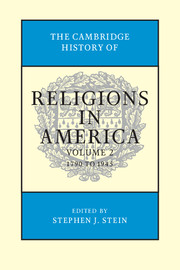Book contents
- Frontmatter
- Contents
- Contributors
- Editor's Introduction
- SECTION I RELIGION IN NORTH AMERICA
- SECTION II RELIGIONS IN THE NEW NATION, 1790–1865
- SECTION III CHANGING RELIGIOUS REALITIES
- SECTION IV RELIGIOUS RESPONSES TO MODERN LIFE AND THOUGHT
- SECTION V COMPARATIVE ESSAYS
- SECTION VI RELIGION AND DIVERSE AREAS
- 34 Religion and Literature, 1790–1945
- 35 Religious Music: A Mirror and Shaper of American Christianity
- 36 Religion and the News
- 37 Religion and the Media, 1790–1945
- 38 Religion and the Courts, 1790–1947
- 39 Religion and Patriotism in America, 1790–Present
- Index
- References
37 - Religion and the Media, 1790–1945
from SECTION VI - RELIGION AND DIVERSE AREAS
Published online by Cambridge University Press: 28 July 2012
- Frontmatter
- Contents
- Contributors
- Editor's Introduction
- SECTION I RELIGION IN NORTH AMERICA
- SECTION II RELIGIONS IN THE NEW NATION, 1790–1865
- SECTION III CHANGING RELIGIOUS REALITIES
- SECTION IV RELIGIOUS RESPONSES TO MODERN LIFE AND THOUGHT
- SECTION V COMPARATIVE ESSAYS
- SECTION VI RELIGION AND DIVERSE AREAS
- 34 Religion and Literature, 1790–1945
- 35 Religious Music: A Mirror and Shaper of American Christianity
- 36 Religion and the News
- 37 Religion and the Media, 1790–1945
- 38 Religion and the Courts, 1790–1947
- 39 Religion and Patriotism in America, 1790–Present
- Index
- References
Summary
Religious organizations made innovative and often aggressive use of media and communications technology during the long nineteenth and early twentieth centuries, shaping those technologies and their cultural impacts in complex ways. Earlier the invention of printing in Europe had unintended consequences for established churches by fostering religious dissent. As print replaced face-to-face human exchanges as the primary medium of social communication and cultural currency, Protestants mastered the printed word as a tool of religious purification. In early America, the adoption of Protestant culture by Native Americans and African slaves included adopting literacy – or at least the recognition of literacy as a central power in Anglo-American society.
However, early Americans got their religious reading from Europe, and domestic markets for religious media took time to develop. By 1790 some parts of the United States had very high literacy rates; in rural New England, for example, few people could not sign their own name to a legal document. Over time a mass reading public emerged both for “high culture” reading such as books and sermons, and “low culture” – broadsides, ballads, newspapers, and tracts. While the centers of production for this mass print culture were urban areas (particularly Philadelphia, Boston, and New York), the distribution and – more importantly – the consumption of print media were decentralized, and the inherent authority of clergy was challenged by an explosion of religious printed matter from nearly none in 1800 to, by midcentury, what Nathan Hatch has called the “grand engine of a burgeoning religious culture.”
One of the earliest examples of the rise of religious publishing and of the development of a richly contested culture of religious reading was the career of Philadelphia printer Mathew Carey. Carey was among the first American publishers to exploit a national market and to compete successfully with books from England, creating a massive distribution system comprising book agents, the most famous and tireless of whom was Episcopal parson Mason Locke Weems, author of a pithy fi ctionalized biography of George Washington.
- Type
- Chapter
- Information
- The Cambridge History of Religions in America , pp. 812 - 831Publisher: Cambridge University PressPrint publication year: 2000



